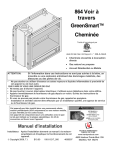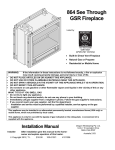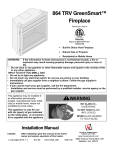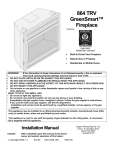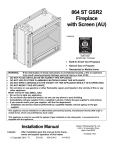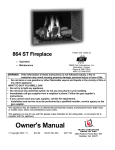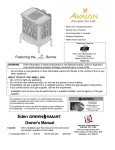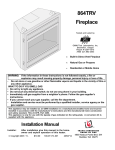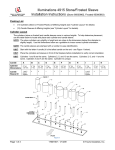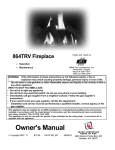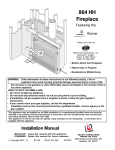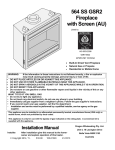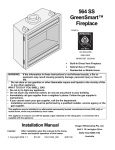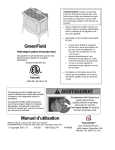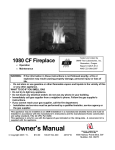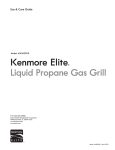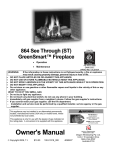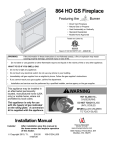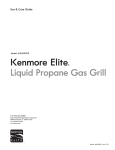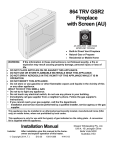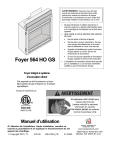Download Omni Group GREEN SMART 864 User's Manual
Transcript
864 See Through GreenSmart™ Fireplace Tested and Listed by OMNI-Test Laboratories, Inc. Portland, Oregon Report # 028-F-84-5 ANSI Z21.88b-2003 • Built-In Direct Vent Fireplace • Natural Gas or Propane • Residential or Mobile Home WARNING: If the information in these instructions is not followed exactly, a fire or explosion may result causing property damage, personal injury or loss of life. - Do not store or use gasoline or other flammable vapors and liquids in the vicinity of this or any other appliance. WHAT TO DO IF YOU SMELL GAS • Do not try to light any appliance. • Do not touch any electrical switch; do not use any phone in your building. • Immediately call gas supplier from a neighbor's phone. Follow the gas supplier's instructions. • If you cannot reach your gas supplier, call the fire department. - Installation and service must be performed by a qualified installer, service agency or the gas supplier. This appliance may be installed in an aftermarket permanently located, manufactured home (USA only) or mobile home, where not prohibited by local codes. This appliance is only for use with the type(s) of gas indicated on the rating plate. A conversion kit is supplied with the appliance. Installation Manual Installer: After installation give this manual to the homeowner and explain operation of this heater. © Copyright 2009, T.I. $10.00 100-01217_000 4090507 www.travisproducts.com 4800 Harbour Pointe Blvd. SW Mukilteo, WA 98275 2 Introduction Overview This manual details the installation requirements for the 864 See Through (ST) GS fireplace. For operating and maintenance instructions, refer to the 864 ST GS Owner's Manual (part # 10001218). Listing Details This appliance was listed by OMNI Test Labs to ANSI Z21.88 - report # 028-F-84-5. The listing label is attached to the appliance near the gas control valve. A copy is shown to the right. IAS (ICBO) Approval This appliance was listed by OMNI Test Labs - IAS # TL130. Massachusetts Approval This manual has been submitted to the Massachusetts Board of State Examiners of Plumbers and Gas Fitters National Fireplace Institute © Travis Industries 4090507 100-01217_000 Table of Contents Introduction Installation (continued) Overview ............................................................................. 2 Listing Details ...................................................................... 2 Safety Precautions Safety Precautions .............................................................. 4 Features and Specifications Features .............................................................................. 6 Installation Options.............................................................. 6 Heating Specifications ......................................................... 6 Dimensions ......................................................................... 6 Installation Packing List ......................................................................... 7 Additional Items Required ................................................... 7 Recommended Installation Procedure ................................ 7 Side Standoff Installation .................................................... 7 Massachusetts Requirements ............................................. 8 Converting the Fireplace to Side Vent Configuration .......... 9 Fireplace Placement Requirements .................................... 11 Clearances ...................................................................... 11 Raised Fireplaces ............................................................ 11 Min. Framing Dims. - Rear Vent Configuration ...........................12 Nailing Brackets .............................................................. 13 Gas Line Requirements ...................................................... 14 Fuel ................................................................................. 14 Gas Line Connection ....................................................... 14 Gas Inlet Pressure ........................................................... 14 Gas Line Location............................................................ 14 Electrical Connection (required) .......................................... 16 Optional Wall Switch or Thermostat Installation .................. 17 Vent Requirements ............................................................. 18 Vent Clearances .............................................................. 18 Altitude Considerations.................................................... 18 Approved Vent ................................................................. 19 Vent Installation ............................................................... 19 Approved Vent Configurations ............................................ 20 Restrictor Position ........................................................... 20 Exhaust Restrictor Adjustment ........................................ 20 Intake Restrictor Adjustment ........................................... 21 Diffuser Plate Adjustment ................................................ 22 Rear Vent Config. W Horizontal Term. (no vertical rise) ..... 23 Rear Vent Config. W Horizontal Term. (w vertical rise) ....... 24 Side Vent Configuration with Vertical Termination .............. 25 Top Vent Configuration with Horizontal Termination ........... 26 Top Vent Configuration with Vertical Termination ............... 27 Termination Requirements .................................................. 28 © Travis Industries 3 Hearth Requirements .......................................................... 29 Facing Requirements .......................................................... 30 Drywall Installation .......................................................... 30 Facing Overview ............................................................. 31 Optional Faceplates – Sizing Chart ................................. 31 Thin Facing Installation ................................................... 32 Thick Facing Installation .................................................. 34 Thick Facing Installation with FPX Arched Faces............ 35 Mantel Requirements .......................................................... 37 Finalizing the Installation Steps for Finalizing the Installation ..................................... 38 Air Shutter Adjustment .................................................... 39 Glass Frame Removal and Installation ............................... 40 Log Set Installation ............................................................. 42 LP Conversion Instructions ................................................. 52 Optional Equipment Fireback Installation ............................................................ 55 Grill Installation ................................................................... 57 Extra Room Power Heat Duct ............................................. 58 Andiron Installation ............................................................. 59 GreenSmart™ Remote Control Installation ......................... 60 Index Index ................................................................................... 72 4090507 100-01217_000 4 Safety Precautions Safety Warnings: • Failure to follow all of the requirements may result in property damage, bodily injury, or even death. • This unit must be installed by a qualified installer to prevent the possibility of an explosion. • This appliance must be installed in accordance with all local codes, if any; if not, in U.S.A. follow ANSI Z223.1 and NFPA 54(88). • A manufactured home (USA only) or mobile home OEM installation must conform with the Manufactured Home Construction and Safety Standard, Title 24 CFR, Part 3280, or, when such a standard is not applicable, the Standard for Manufactured Home Installations, ANSI/NCSBCS A225.1, or Standard for Gas Equipped Recreational Vehicles and Mobile Housing, CSA Z240.4. This appliance may be installed in Manufactured Housing only after the home is site located. • All exhaust gases must be vented outside the structure of the living-area. Combustion air is drawn from outside the living-area structure. The venting must not be connected to a chimney flue serving a separate solid-fuel burning appliance. • Notify your insurance company before hooking up this fireplace. • The room heater should be inspected before use and at least annually by a qualified service person. More frequent cleaning may be required due to excessive lint from carpeting, bedding material, etc. • The instructions in this manual must be strictly adhered to. Do not use makeshift methods or compromise in the installation. Improper installation will void the warranty and safety listing. • This heater is approved for use with natural gas (NG) or propane (LP). Burning the incorrect fuel will void the warranty and safety listing and may cause an extreme safety hazard. Direct questions about the type of fuel used to your dealer. Check the label and flame adjust knob on the gas control valve. • Contact your local building officials to obtain a permit and information on any installation restrictions or inspection requirements in your area. • If the flame becomes sooty, dark orange in color, or extremely tall, do not operate the heater. Call your dealer and arrange for proper servicing. • It is imperative that control compartments, screens, or circulating air passageways of the heater be kept clean and free of obstructions. These areas provide the air necessary for safe operation. • Do not operate the heater if it is not operating properly in any fashion or if you are uncertain. Call your dealer for a full explanation of your heater and what to expect. • Do not store or use gasoline or other flammable liquids in the vicinity of this heater. • Do not operate if any portion of the heater was submerged in water or if any corrosion occurs. • Do not place clothing or other flammable items on or near the heater. Because this heater can be controlled by a thermostat there is a possibility of the heater turning on and igniting any items placed on or near it. • Light the heater using the built-in igniter. Do not use matches or any other external device to light your heater. • Never remove, replace, modify or substitute any part of the heater unless instructions are given in this manual. All other work must be done by a trained technician. Don't modify or replace orifices. • The viewing glass should be opened only for conducting service. • Any safety screen or guard removed for servicing must be replaced prior to operating the heater. © Travis Industries 4090507 100-01217_000 Safety Precautions 5 Safety Warnings (continued): • Allow the heater to cool before carrying out any maintenance or cleaning. • Operate the heater according to the instructions included in this manual. • If the main burners do not start correctly turn the gas off and call your dealer for service. • This unit is not for use with solid fuel. • Do not place anything inside the firebox (except the included fiber logs). • If the fiber logs become damaged, replace with Travis Industries log set. • Do not throw this manual away. This manual has important operating and maintenance instructions that you will need at a later time. Always follow the instructions in this manual. • Do not touch the hot surfaces of the heater. Educate all children of the danger of a high-temperature heater. Young children should be supervised when they are in the same room as the heater. • Due to the high temperature, the heater should be located out of traffic and away from furniture and draperies. • Instruct everyone in the house how to shut gas off to the appliance and at the gas main shutoff valve. The gas main shutoff valve is usually next to the gas meter or propane tank and requires a wrench to shut off. • Travis Industries, Inc. grants no warranty, implied or stated, for the installation or maintenance of your heater, and assumes no responsibility of any consequential damage(s). © Travis Industries 4090507 100-01217_000 6 Features and Specifications Installation Options • Residential or Mobile Home • Internal or External Chase • Flush or Recessed Face • Horizontal or Vertical Vent • Raised or Floor Placement • Bedroom Approved Heating Specifications Approximate Heating Capacity (in square feet)* Maximum BTU Input Per Hour * Natural Gas Propane Up to 1,500 (139 sq. M) Up to 1,500 (139 sq. M) 37,500 (39.5 MJ) 37,500 (39.5 MJ) Heating capacity will vary with floor plan, insulation, and outside temperature. Dimensions 38-1/4" 972mm Top Vent Configuration 39-1/8" 994mm 8" (203mm) Diameter Vent 4-3/8" 111mm 41-1/2" 1054mm 3-3/8" 86mm 38-1/4" 972mm Side Vent Configuration 35-1/4" 8" (203mm) Diameter Vent 895mm 37" 940mm 33-7/8" 860mm Lifting Handle Tabs m 1m 04 1 " 41 These tabs may be used in conjuction with the lifting handles (98500711) - make sure to use the required adapters (250-01038) © Travis Industries Ba ck mm 18 1 "1 44 24" 610mm ht Rig ft Le Fro nt 1" 25mm Weight: 310 Lbs (140.7 kg) 4090507 100-01217_000 Installation (for qualified installers only) 7 Packing List • • • • • • • Propane Conversion Kit Log Set Firestop (sku 93006094) Right Side Standoffs (2) Wall Switch, Cover Plate, and Wire 4 AA Batteries, 1 9-Volt Battery Insulation for Side Vent Conversion Additional Items Required • • • • Direct Vent Gas Line Equipment (shutoff valve, pipe, etc.) Electrical Equipment (min. 14 gauge, grounded line) Two Grill Kits and/or Faces Recommended Installation Procedure • • • • • • • • • • • Prepare the framing, making sure to leave the area around the fireplace open (see page 12). Make sure to allow for vent installation and facing depth. Place the fireplace into position. Install the vent, gas line and electrical hook-up. Finalize the framing around the fireplace. Secure the fireplace to the framing. Install the wall switch (see page 17) or thermostat (if applicable). Install the drywall. Install the hearth (if applicable). Install the facing (if applicable). Install the mantel (if applicable). Finalize the installation (see page 38) and install the grill or face. Side Standoff Installation The two right-side standoffs included with this fireplace are attached to the fireplace prior to placing the fireplace into position. These standoffs are not required for safety purposes. Their purpose is to center the fireplace in the framed opening. Attach the right side standoffs to the fireplace as shown below. Remove the five screws on the side of the fireplace, position the standoff, and secure. NOTE: The side standoffs have obround holes that allow for the standoff to be adjusted for drywall of ½” or 5/8” thickness. See “Nailing Brackets” on page 13. Framing Notes The framing dimensions included in this installation manual have been revised to include the extra 1-1/2” needed for the right standoffs to install correctly (44” width). If the fireplace opening has been framed to the dimensions listed in the previous version of the installation manual (42-1/2” width), the right side standoffs may be excluded. In this type of installation, the center of the glass will not be located in the center of the framed opening. The center of the glass will be ¾” from the center of the framing. © Travis Industries 4090507 100-01217_000 8 Installation (for qualified installers only) Massachusetts Requirements NOTE: The following requirements reference various Massachusetts and national codes not contained in this document. Requirements for the Commonwealth of Massachusetts For all side wall horizontally vented gas fueled equipment installed in every dwelling, building or structure used in whole or in part for residential purposes, including those owned or operated by the Commonwealth and where the side wall exhaust vent termination is less than seven (7) feet above finished grade in the area of the venting, including but not limited to decks and porches, the following requirements shall be satisfied: Installation of Carbon Monoxide Detectors At the time of installation of the side wall horizontal vented gas fueled equipment, the installing plumber or gasfitter shall observe that a hard wired carbon monoxide detector with an alarm and battery back-up is installed on the floor level where the gas equipment is to be installed. In addition, the installing plumber or gasfitter shall observe that a battery operated or hard wired carbon monoxide detector with an alarm is installed on each additional level of the dwelling, building or structure served by the side wall horizontal vented gas fueled equipment. It shall be the responsibility of the property owner to secure the services of qualified licensed professionals for the installation of hard wired carbon monoxide detectors. In the event that the side wall horizontally vented gas fueled equipment is installed in a crawl space or an attic, the hard wired carbon monoxide detector with alarm and battery back-up may be installed on the next adjacent floor level. In the event that the requirements of this subdivision can not be met at the time of completion of installation, the owner shall have a period of thirty (30) days to comply with the above requirements; provided, however, that during said thirty (30) day period, a battery operated carbon monoxide detector with an alarm shall be installed. Approved Carbon Monoxide Detectors Each carbon monoxide detector as required in accordance with the above provisions shall comply with NFPA 720 and be ANSI/UL 2034 listed and IAS certified. Signage A metal or plastic identification plate shall be permanently mounted to the exterior of the building at a minimum height of eight (8) feet above grade directly in line with the exhaust vent terminal for the horizontally vented gas fueled heating appliance or equipment. The sign shall read, in print size no less than one-half (1/2) inch in size, “GAS VENT DIRECTLY BELOW. KEEP CLEAR OF ALL OBSTRUCTIONS”. Inspection The state or local gas inspector of the side wall horizontally vented gas fueled equipment shall not approve the installation unless, upon inspection, the inspector observes carbon monoxide detectors and signage installed in accordance with the provisions of 248 CMR 5.08(2)(a)1 through 4. Exemptions The following equipment is exempt from 248 CMR 5.08(2)(a)1 through 4: • The equipment listed in Chapter 10 entitled “Equipment Not Required To Be Vented” in the most current edition of NFPA 54 as adopted by the Board; and • Product Approved side wall horizontally vented gas fueled equipment installed in a room or structure separate from the dwelling, building or structure used in whole or in part for residential purposes. MANUFACTURER REQUIREMENTS Gas Equipment Venting System Provided When the manufacturer of Product Approved side wall horizontally vented gas equipment provides a venting system design or venting system components with the equipment, the instructions provided by the manufacturer for installation of the equipment and the venting system shall include: • Detailed instructions for the installation of the venting system design or the venting system components; and • A complete parts list for the venting system design or venting system. Gas Equipment Venting System NOT Provided When the manufacturer of a Product Approved side wall horizontally vented gas fueled equipment does not provide the parts for venting the flue gases, but identifies “special venting systems”, the following requirements shall be satisfied by the manufacturer: • The referenced “special venting system” instructions shall be included with the appliance or equipment installation instructions; and • The “special venting systems” shall be Product Approved by the Board, and the instructions for that system shall include a parts list and detailed installation instructions. A copy of all installation instructions for all Product Approved side wall horizontally vented gas fueled equipment, all venting instructions, all parts lists for venting instructions, and/or all venting design instructions shall remain with the appliance or equipment at the completion of the installation. See Gas Connection section for additional Commonwealth of Massachusetts requirements. © Travis Industries 4090507 100-01217_000 Installation 9 (for qualified installers only) Top Vent or Side Vent Configuration This appliance is shipped in the top vent configuration. To change to the side vent configuration, follow the directions below. NOTE: the vent configuration affects several aspects of installation (framing, maximum vent rise, maximum vent run). Make sure the vent configuration is correct prior to installation. You may wish to configure the diffuser when changing the vent configuration. Converting the Fireplace to Side Vent Configuration Remove the back plate on the fireplace. NOTE: Use a magnetic-tipped nutdriver on these screws take care to prevent the screws from falling into the fireplace. Remove the flue assembly. Tuck the two 24" (610mm) pieces of insulation into the area between the exhaust manifold and fireplace can. WARNING: Failure to properly place the insulation will void the warranty and create a safety hazard. © Travis Industries 4090507 100-01217_000 10 Converting the Fireplace to Side Vent (continued) Installation (for qualified installers only) Re-attach the flue assembly in the side position. Tuck the two 20" (508mm) pieces of insulation into the area above the exhaust manifold and fireplace can. Note how the insulation is folded in half and covers the entire area above the exhaust manifold (see illustration below). WARNING: Failure to properly place the insulation will void the warranty and create a safety hazard. Re-attach the back plate to the top of the fireplace. NOTE: Make sure the flange on the back plate tucks between the fireplace and the flue assembly. © Travis Industries 4090507 100-01217_000 Installation 11 (for qualified installers only) Fireplace Placement Requirements • Fireplace must be installed on a level surface capable of supporting the fireplace and vent. • Fireplace must be placed directly on wood or non-combustible surface (not on linoleum or carpet). • This heater may be placed in a bedroom. Please be aware of the large amount of heat this appliance produces when determining a location. • Fireplace must be installed in a room with a minimum ceiling height of 84” (2134mm). Clearances • The fireplace requires a ½” (13mm) clearance from the left side of the fireplace to the framing members. No material (insulation, framing, etc.) may be placed into this area. 0" (0mm) clearance on 1/2" (13mm) Clearnce on left side of fireplace. right side of fireplace. NOTE: right side standoff is optional. • When installed, walls in front of the fireplace must be a minimum 1" (25mm) to the side of the fireplace. Only one side wall is allowed within 12” (305mm) of the side of the fireplace. • Due to the high temperature, the heater should be located out of traffic and away from furniture and draperies. • Fireplace must be placed so the vents below and above the glass do not become blocked. Raised Fireplaces • The fireplace (and hearth, if desired) may be placed on a platform designed to support the fireplace (310 Lbs. 140.7 Kg) and vent. Min. 42" (1067mm) Fireplace Enclosure Height Platform Optional Raised Hearth (see "Hearth Requirements" for details) © Travis Industries 4090507 100-01217_000 12 Installation (for qualified installers only) Minimum Framing Dimensions – Top or Side Vent Configuration Minimum 42”(1067mm) Fireplace Enclosure Height NOTE: The shaded framing must be installed after placing the fireplace in position. The framing above the fireplace interferes with the top of the fireplace. If using the side vent configuration, do not install the framing to the left side (shown in light gray). 38-1/2" 978mm 44" 1118mm 23" * 584mm Le ck ft Ba nt Fro © Travis Industries Rig ht * The 23" (584mm) dimension is based upon 1/2" (13mm) drywall around the perimeter of the fireplace on both sides. If using thicker drywall (or other facing), you will need to adjust this dimension. 4090507 100-01217_000 Installation (for qualified installers only) 13 Nailing Brackets There are eight nailing brackets on the front and back of the fireplace. Bend the tabs out to position the nailing brackets. Once in place, nail or screw the nailing brackets to the framing. WARNING: Make sure the fireplace is square and plumb when placed in the framing. Measured corner-to-corner, the fireplace should be square (approx. 54-7/8"or 1394mm for each dimension). Use shims to insure the fireplace is square. NOTE: Additional nailing brackets are provided along the base of the fireplace. Use these brackets if not using the front brackets. NOTE: The side standoffs have obround holes that allow for the standoff to be adjusted for drywall of 1/2" or 5/8". NOTE: You may need to bend the tabs out on one side then slide the fireplace out to bend the tabs out on the opposite side TOP VIEW Framing Nailing Bracket Fireplace Drywall © Travis Industries 4090507 100-01217_000 14 Installation (for qualified installers only) Gas Line Requirements MASSACHUSETTS INSTALLATIONS - WARNING: THIS PRODUCT MUST BE INSTALLED BY A LICENSED PLUMBER OR GAS FITTER WHEN INSTALLED WITHIN THE COMMONWEALTH OF MASSACHUSETTS. OTHER MASSACHUSETTS CODE REQUIREMENTS: • Flexible connector must not be longer than 36 inches. • Shutoff valve must be a “T” handle gas cock. • Only direct vent sealed combustion products are approved for bedrooms or bathrooms. • Fireplace dampers must be removed or welded in the open position prior to the installation of a fireplace insert or gas log. • A carbon monoxide (CO) detector is required in the same room as the appliance. • The gas line must be installed in accordance with all local codes, if any; if not, follow ANSI 223.1 and the requirements listed below. The fireplace and gas control valve must be disconnected from the gas supply piping during any pressure testing of that system at test pressures in excess of 1/2 psig (3.5 kPA). For pressures under 1/2 psig (kPA), isolate the gas supply piping by closing the manual shutoff valve. Leak test all gas line joints and the gas control valve prior to and after starting the fireplace. • • Fuel • This fireplace is designed either for natural gas or for propane (but not for both). Check the sticker on the top of the gas control valve to make sure the correct fuel is used. Gas Line Connection • Installation must be performed by a qualified installer, service agency or the gas supplier (In Massachusetts a licensed plumber/gasfitter). Standard Input Pressure Gas Inlet Pressure Natural Gas Propane • • 7" W.C. (1.74 kPA) 13" W.C. (2.73 kPA) If the pressure is not sufficient, make sure the piping used is large enough, the supply regulator is adequately adjusted, and the total gas load for the residence does not exceed the amount supplied. The supply regulator (the regulator that attaches directly to the residence inlet or to the propane tank) should supply gas at the suggested input pressure listed above. Contact the local gas supplier if the regulator is at an improper pressure. © Travis Industries 4090507 100-01217_000 Installation 15 (for qualified installers only) Gas Line Location Right Side Gas Inlet (preferred) A 2" (51mm) by 3" (76mm) opening is located behind the gas inlet cover plate. It is centered 3" (76mm) above the base of the fireplace. A 8" (203mm) flex tube and shutoff valve is included with the fireplace. The shutoff valve accepts a 1/2"MPT. 9-1/4" 235mm 9" 229mm The gas inlet is located 1-1/4" (32mm) above the base of the fireplace. You may remove this cover plate to install the gas line. The cover plate has a 7/8" (22.2mm) diameter hole (covered with a push plug) in line with the gas inlet on the gas control valve. By rotating the plate 180° the hole may be re-located. You may also secure the plate in a customized location using the self-drilling screws. Left Side Gas Inlet An additional 2" (51mm) by 3" (76mm) opening is located the left side. It is centered 3" (76mm) above the base of the fireplace. A 8" (203mm) flex tube and shutoff valve is included with the fireplace. You may wish to use a 24" (610mm) or 36" (914mm) flex tube. The shutoff valve accepts a 1/2" MPT. 5-3/8" 137mm You may remove this cover plate to install the gas line. The cover plate has a 7/8" (22.2mm) diameter hole (covered with a push plug) in line with the gas inlet on the gas control valve. By rotating the plate 180° the hole may be relocated. You may also secure the plate in a customized location using the self-drilling screws. © Travis Industries 4090507 100-01217_000 16 Installation (for qualified installers only) Electrical Connection (required) • The electrical line to the grounded receptacle inside the fireplace must be installed by a qualified installer and must meet all local codes. • Make sure the household breaker is shut off prior to working on any electrical lines. • The appliance, when installed, must be electrically grounded in accordance with local codes or, in the absence of local codes, with the National Electrical Code, ANSI/NFPA 70, or the Canadian Electrical Code, CSA C22.1. • The electrical line must be a min. 14 gauge, and supply 120 Volts at 60 Hz (2 Amps). Caution: Label all wires prior to disconnection when servicing controls. Wiring errors can cause improper and dangerous operation. a © Travis Industries c b 4090507 d 100-01217_000 Installation 17 (for qualified installers only) Optional Wall Switch or Thermostat Installation Do not connect 110-120 VAC to the gas control valve or wiring system of this fireplace. The switch and wiring must be installed by a qualified installer. This fireplace includes an optional wall switch (with wire) to operate the fireplace burner without accessing the internal on/off switch. A thermostat may be used instead. OPTIONAL WALL SWITCH (included with fireplace) Route the wire from inside the fireplace, through the grommet on either side of the fireplace near the gas inlet (see at right) to the switch. The wall switch (or thermostat) may bypass the fireplace on/off switch or be installed in Place "WARNING" label on switch cover. parallel or series configuration (see below). Caution: Label all wires prior to disconnection when servicing controls. Wiring errors can cause improper and dangerous operation. Note: When using a GreenSmart™ remote, use the receiver for on/off operation (do not use a wall switch or thermostat). Make sure all wiring is secure and does not contact hot or moving components. Warning: Parallel Connection Thermostat / External Switch ON Thermostat / External Switch OFF Series Connection On / Off Switch ON Heater is ON On / Off Switch OFF Heater is ON Heater is ON Heater is OFF To wire the heater in parallel, follow the directions below: a Thermostat / External Switch ON Thermostat / External Switch OFF On / Off Switch ON Heater is ON On / Off Switch OFF Heater is OFF Heater is OFF Heater is OFF To wire the heater in series, follow the directions below: a b On / Off Switch b On / Off Switch Thermostat (or External Switch) Wires Thermostat (or External Switch) Wires c c © Travis Industries 4090507 100-01217_000 18 Installation (for qualified installers only) Vent Requirements • The gas appliance and vent system must be vented directly to the outside of the building, and never be attached to a chimney serving a separate solid fuel or gas-burning appliance. Each direct vent gas appliance must use its own separate vent system. • In addition to the requirements listed here, follow the requirements provided with the vent. • A firestop is required whenever the vent penetrates a wall, floor, or ceiling (passes through framing members). Horizontal vent less than 48" (1219mm) above the fireplace must use the Travis Firestop (sku 93006094 - it incorporates a 3" (76mm) clearance above, 1" (25mm) clearance below and to the sides of the vent). Other penetrations only require a 1" (25mm) clearance and may use a standard firestop (make sure the required 1" (25mm) clearance is met). Vent Clearances • The vent must maintain the required clearance to combustible materials to prevent a fire. Do not fill air spaces with insulation. Before 48" (1219mm) Rise After 48" (1219mm) Rise Sides 1" (25mm) 1" (25mm) Above 3" (76mm) 1" (25mm) Below Horizontal or 45° Section 1" (25mm) 1" (25mm) Vertical Termination Horizontal Required Firestop Termination Use a roof flashing and storm collar whenever passing through the roof Min. 3" (76mm) (1" or 25mm if a Use a firestop whenever passing through a ceiling Use a support box on exposed vent minimum 48"or 1219mm above the fireplace) Min. 1"(25mm) Min. 1" (25mm) Min. 1" (25mm) Altitude Considerations • This heater has been tested at altitudes ranging from sea level to 6,000 feet (1800 M). In this testing we have found that the heater, with its standard orifice, burns correctly with just an air shutter adjustment. • Failure to adjust the air shutter properly may lead to improper combustion which can create a safety hazard. Consult your dealer or installer if you suspect an improperly adjusted air shutter. © Travis Industries 4090507 100-01217_000 Installation 19 (for qualified installers only) Approved Vent • Side vent configurations use 8" (203mm) diameter Simpson Dura-Vent Model Direct-Vent Pro (or GS)*. • Top vent configurations use 8" (203mm) or 6-5/8" (168mm) diameter Simpson Dura-Vent Direct-Vent Pro (or GS)*. If using 6-5/8" (168mm) diameter vent, attach the 8" (203mm) to 6-5/8" (168mm) reducer (Travis part # 98900165) to the fireplace. NOTE: When using 6-5/8” (168mm) diameter vent, make sure to accommodate the 3” (76mm) clearance above the vent for the first 48” (1219mm) of rise (see vent clearances on page 18). Standard firestops do not include this clearance. * Other vent may be approved with this fireplace. Check with the vent manufacturer for details. • Always use the high-wind cap (or high-wind sconce cap, part # 58DVA-HSCH or 46DVA-HSCH). • Installation instructions for Simpson Dura-Vent may be found at www.duravent.com 6-5/8" (168mm) Diameter Vent Reducer - # 98900165 Vent Installation • Slide the vent sections together and turn 1/4 turn until the sections lock in place. • Screws are not required to secure the vent. However, three screws may be used to secure vent sections together if desired. • High temperature sealant is recommended at the appliance starter section connection (use high-temperature silicone or Mill-Pac®). • If disassembly is required, at time of re-assembly check to see if the vent creates a tight fit. If it does not, apply high temperature sealant to the joints of the affected sections. • Horizontal sections require a 1/4" (6mm) rise every 12" (305mm) of travel • Horizontal sections require non-combustible support every three feet (e.g.: plumbing tape) © Travis Industries 4090507 100-01217_000 20 Installation (for qualified installers only) Approved Vent Configurations Restrictor Position • Intake and exhaust restrictors are built into the appliance to adjust the flow rate of intake air and exhaust gases. Depending upon the vent configuration, you may be required to adjust the restrictor positions. The charts for acceptable vent configurations detail the correct vent restrictor positions. Exhaust Restrictor Adjustment If the diffuser is required to be in position # 2, you may wish to adjust the diffuser while the exhaust restrictor is removed. Firebo Left W x Roo f all of F irebox Loosen these two screws on the exhaust restrictor. Slide the restrictor to the correct restrictor position (see the illustration below). The screw location indicates restrictor position. In this example, the restrictor is set in position # 3. Tighten the screws to secure the restrictor. (closed) #6 #5 #4 #3 #2 (open - stock position) # 1 Left (vent) Side of Firebox © Travis Industries 4090507 100-01217_000 Installation 21 (for qualified installers only) Intake Restrictor Adjustment The intake restrictor is shipped in position # 1 (open). To adjust the restrictor to position # 2 (closed), follow the directions below. Restrictor Plate Remove this screw. Rotate the restrictor plate so the left side hole lines up with the screw-hole. Re-attach the screw to lock the restrictor plate in position # 2. © Travis Industries 4090507 100-01217_000 22 Installation (for qualified installers only) Diffuser Plate Adjustment Certain vent configurations require the diffuser plate to be adjusted (refer to the approved vent configuration charts for details). See the directions below to change the diffuser to position. Firebo Back W all of F x Roo irebox f Remove the exhaust restrictor. 1/4" Nutdriver 1/4" Nutdriver Remove the diffuser. DIFFUSER SIDE VIEW Before (Stock - Position # 2) Bend the round portion of the diffuser 90° (position # 1). After (Position # 1) Secure the diffuser plate with the screws removed earlier. Replace the exhaust restrictor (see “Exhaust Restrictor Adjustment” for restrictor settings). © Travis Industries 4090507 100-01217_000 Installation 23 (for qualified installers only) Side Vent Configuration with Horizontal Termination (no vertical rise) • The termination must fall within the shaded area shown in the chart. Use the indicated restrictor and diffuser positions. HINT: Travis Industries provides a minmum vent kit (sku 98900168). It includes a 4” (102mm) section and a horizontal termination cap. See the charts below to determine maximum vent Termination Optional 45° Elbow Vent with No 45° Elbow 3 feet (0.915m) • Exhaust Restrictor # 1 (stock) • Intake Restrictor # 1 (stock) • Diffuser Position # 1 4' max 1.22m) 0 feet 0 feet • Min. 4" (102mm) Horizontal Section • Max.48" (1219mm) Horizontal Section(s) Vent with 1 45° Elbow • Exhaust Restrictor # 1 (stock) 3 feet (0.915m) • Intake Restrictor # 1 (stock) • Diffuser Position # 1 © Travis Industries 2' max (0.61m)) 0 feet 0 feet 4090507 • Min. 4" (102mm) Horizontal Section • Max. 24" (610mm) Horizontal Section(s) 100-01217_000 24 Installation (for qualified installers only) Side Vent Configuration with Horizontal Termination (with vertical rise) • Only one horizontal elbow may be used. 10 feet (3m) 20' max (6m) Up to four elbows (45° or 90°) may be used. 15 feet (4.5m) • 5 feet (1.5m) The termination must fall within the shaded area shown in the chart. Use the indicated restrictor and diffuser positions. 0 feet • 22' max (6.7m) 22' max (6.7m) Exhaust Restrictor # 4 Intake Restrictor # 2 20 feet (6m) 20 feet (6m) Diffuser Position # 2 (stock) Exhaust Restrictor # 4 Intake Restrictor # 1 Diffuser Position # 1 15 feet (4.5m) 15 feet (4.5m) Exhaust Restrictor # 2 (stock) Intake Restrictor # 1 (stock) Diffuser Position # 1 10 feet (3m) 10 feet (3m) 5 feet (1.5m) 5 feet (1.5m) 0 feet 20' max (6m) 15 feet (4.5m) 10 feet (3m) 5 feet(1.5m) 0 feet 0 feet H2 This is considered a horizontal Horizontal length is calculated by adding elbow (it does not matter both lengths of horizontal run whether it turns right or left). (Horizontal Length = H1 + H2). It may be a 90° or 45° elbow. H1 This is considered a vertical elbow © Travis Industries 4090507 100-01217_000 Installation 25 (for qualified installers only) • Only one horizontal elbow may be used. 20' max (6m) Up to four elbows (45° or 90°) may be used. 15 feet (4.5m) • 10 feet (3m) The termination must fall within the shaded area shown in the chart. Use the indicated restrictor and diffuser positions. 5 feet (1.5m) • 0 feet Side Vent Configuration with Vertical Termination 40' max (12m) 40' max (12m) 35 feet (10.5m) 35 feet (10.5m) 30 feet (9m) 30 feet (9m) Exhaust Restrictor # 4 Intake Restrictor # 2 25 feet (7.5m) 25 feet (7.5m) Diffuser Position # 1 20 feet (6m) 20 feet (6m) Exhaust Restrictor # 2 15 feet (4.5m) 15 feet (4.5m) Intake Restrictor # 1 Diffuser Position # 1 10 feet (3m) 10 feet (3m) 5 feet (1.5m) 5 feet (1.5m) 0 feet 20' max (6m) 15 feet (4.5m) 10 feet (3m) 5 feet (1.5m) 0 feet 0 feet H2 This is considered a horizontal Horizontal length is calculated by adding elbow (it does not matter both lengths of horizontal run whether it turns right or left). (Horizontal Length = H1 + H2). It may be a 90° or 45° elbow. H1 This is considered a vertical elbow © Travis Industries 4090507 100-01217_000 26 Installation (for qualified installers only) Top Vent Configuration with Horizontal Termination Up to four elbows (45° or 90°) may be used. • May use 8" (203mm) or 6-5/8" (168mm) diameter vent (see page for 18 details). • Only one horizontal elbow may be used. 20 feet (6m) 10 feet (3m) 0 feet 21' max (6.4m) 20' max (6m) • 15 feet (4.5m) The termination must fall within the shaded area shown in the chart. Use the indicated restrictor and diffuser positions. 5 feet (1.5m) • Exhaust Restrictor # 4 21' max (6.4m) Intake Restrictor # 2 20 feet (6m) Diffuser Position # 2 (stock) Exhaust Restrictor # 4 Intake Restrictor # 1 (stock) Diffuser Position # 2 (stock) 15 feet (4.5m) 15 feet (4.5m) Exhaust Restrictor # 2 Intake Restrictor # 1 (stock) Diffuser Position # 2 (stock) 10 feet (3m) 10 feet (3m) 5 feet (1.5m) 5 feet (1.5m) 0 feet 20' max (6m) 15 feet (4.5m) 10 feet (3m) 5 feet (1.5m) 0 feet 0 feet H2 This is considered a horizontal Horizontal length is calculated by adding elbow (it does not matter both lengths of horizontal run whether it turns right or left). (Horizontal Length = H1 + H2). It may be a 90° or 45° elbow. H1 This is considered a vertical elbow © Travis Industries 4090507 100-01217_000 Installation 27 (for qualified installers only) • Up to four elbows (45° or 90°) may be used. • Only one horizontal elbow may be used. • May use 8" (203mm) or 6-5/8" (168mm) diameter vent (see page for 18 details). 20' max (6m) 15 feet (4.5m) 10 feet (3m) The termination must fall within the shaded area shown in the chart. Use the indicated restrictor and diffuser positions. 0 feet • 5 feet (1.5m) Top Vent Configuration with Vertical Termination 40' max (12m) 40' max (12m) 35 feet (10.5m) 35 feet (10.5m) Exhaust Restrictor # 4 30 feet (9m) 30 feet (9m) Intake Restrictor # 2 Diffuser Position # 2 (stock) 25 feet (7.5m) 25 feet (7.5m) 20 feet (6m) 20 feet (6m) 15 feet (4.5m) 15 feet (4.5m) Exhaust Restrictor # 3 Intake Restrictor # 2 Diffuser Position # 2 (stock) 10 feet (3m) 10 feet (3m) 5 feet (1.5m) 5 feet (1.5m) 0 feet 20' max 6m) 15 feet (4.5m) 10 feet (3m) 5 feet (1.5m) 0 feet 0 feet H2 This is considered a horizontal Horizontal length is calculated by adding elbow (it does not matter both lengths of horizontal run whether it turns right or left). (Horizontal Length = H1 + H2). It may be a 90° or 45° elbow. H1 This is considered a vertical elbow © Travis Industries 4090507 100-01217_000 28 Installation (for qualified installers only) Termination Requirements ! Venting terminals shall not be recessed into a wall or siding. A Minimum 9" (229mm) clearance from any door or window B Minimum 12" (305mm) above any grade, veranda, porch, deck or balcony C Minimum 3-3/8" (86mm) from outside corner walls NOTE: Clearance in accordance with local installation codes and the requirements of the gas supplier. Roof Surface Roof Eaves 11" Min. (279mm) 6" Min. (152mm) D Minimum 12" (305mm) from inside corner walls NOTE: Clearance in accordance with local installation codes and the requirements of the gas supplier. E Minimum 11" (279mm) clearance below unventilated soffits or roof surfaces Minimum 18" (457mm) clearance below ventilated soffits Minimum 6" (152mm) clearance below roof eaves NOTE: Vinyl surfaces require 24" (610mm) NOTE: Clearance in accordance with local installation codes and the requirements of the gas supplier. F Minimum 12" (305mm) clearance below a veranda, porch, deck or balcony NOTE: Permitted only if veranda, porch, deck, or balcony is fully open on a minumum of two sides beneath the floor. NOTE: Clearance in accordance with local installation codes and the requirements of the gas supplier. G Minimum 48" (1219mm) clearance from any adjacent building H Minimum 84" (2134mm) clearance above any grade when adjacent to public walkways or driveways NOTE: may not be used over a walkway or driveway shared by an adjacent building I Minimum 9" (229mm) clearance to any nonmechanical air supply inlet to the building or the combustion air inlet to any other appliance. J Minimum 36" (914mm) clearance above any mechanical air supply inlet if within 10’ (3M) horizontally K Minimum 36" (914mm) from the area above the meter/regulator (vent outlet) - this extends 15’ (4.5M) above the regulator NOTE: Clearance in accordance with local installation codes and the requirements of the gas supplier. L Minimum 36" (914mm) from the meter/regulator (vent outlet) NOTE: Clearance in accordance with local installation codes and the requirements of the gas supplier. M Minimum 12” (305mm) above the roof line (for vertical terminations) N Minimum 24” (610mm) horizontal clearance to any surface (such as an exterior wall) – for vertical terminations E N M E E A K G J A F H D I C L B NOTE: Measure clearances to the nearest edge of the exhaust hood. • Use the vinyl siding standoff when installing on an exterior with vinyl siding. • Vent termination must not be located where it will become plugged by snow or other material © Travis Industries 4090507 100-01217_000 Installation 29 (for qualified installers only) Hearth Requirements Do not build a hearth more than 1”(25mm) above the Floor Mounted baseplate (this area must remain clear for the access Fireplaces door). If installed near carpet or other combustible flooring, the fireplace must be raised so the base of the unit is above the carpet surface or flooring material. WARNING: A non-combustible hearth is not required. However, if the heater is installed next to the floor, we recommend a hearth to protect the flooring surface from discoloration or other negative impact from the heater. Raised A hearth is not required Fireplaces when the fireplace is raised above the flooring surface. Fireplace Stand © Travis Industries 4090507 100-01217_000 30 Installation (for qualified installers only) Facing Requirements • This appliance is designed to allow for drywall (or other combustible facing) to contact the sides and top of the front of the fireplace. • Tile or other non-combustible facing may be placed on the front of the fireplace (see "Facing Overview" on page 31 for further details). Drywall Installation Drywall Installation Drywall may be installed up to the front edge of the fireplace. If the fireplace is raised, drywall up to the bottom edge as well. all yw Dr Do not install drywall (or any other combustible) in front of the fireplace. TOP VIEW Framing Fireplace Nailing Bracket Drywall © Travis Industries 4090507 100-01217_000 Installation 31 (for qualified installers only) Facing Overview Upgrade faces are available for this fireplace and may influence facing installation. Consult with your Travis Dealer if you are using an upgrade face. Optional non-combustible facing may be installed on the fireplace. Use the guidelines below to determine the location (also see the following pages for detailed diagrams. Any non-combustible facing under 1" (25mm) thick (see "Thin Facing" on page 32). Masonry Line Any non-combustible over 1" (25mm) thick (see "Thick Facing" on page 34). Hearth Line Non-combustible hearth/facing should be installed up to this location (1" (25mm) above the base of the fireplace). The fireplace may be raised to accommodate thicker hearth materials. Tile Line Masonry Line Tile Line ry n so Ma e in eL e Lin Masonry Line Tile Line Til SPECIAL INSTRUCTIONS FOR WILMINGTON FACES Remove the center deflector (use needlenose pliers if necessary). e Lin ne ry i on ile L s T Ma rth Tile Line Masonry Line a He rth e Lin Masonry Line Tile Line a He e Lin These tabs bend down to allow for removal. Re-attach the deflector to the louver. Bend the tabs as shown, making sure the deflector is secure and flat. WARNING: The deflector must be replaced in its original position if a different face or grill is used. NOTE: The hearth or facing can extend no greater than 1” (25mm) above the base of the fireplace. The fireplace may be raised to accommodate thicker hearth materials. Optional Faceplates – Sizing Chart Name FPX Artisan, Classic, Fr Ctry Winthrop Victorian Lace Wilmington Hearthview Winthrop Bungalow © Travis Industries Height 35-3/4” (908mm) 34-1/8” (867mm) 35-3/4” (908mm) 34” (864mm) Width 41” (1041mm) 36-7/8” (937mm) 41” (1041mm) 36-7/8” (937mm) Notes 45-3/4” (1162mm) Radius – May fit over top of tile facing Optional facing will butte to edge of faceplate (tile line) May fit over top of tile facing Optional facing will butte to edge of faceplate (tile line) 4090507 100-01217_000 32 Installation (for qualified installers only) Thin Facing Installation (tile, marble, or other non-combustible under 1" (25mm) thick) Tile Line Upgrade faces are available for this fireplace and may influence facing installation. Consult with your Travis Dealer if you are using an upgrade face. ine eL Til Facing is installed to this edge of the fireplace. all yw Dr ine hL Do not install tile (or other material) in front of the glass frame, convection channel, or access panel openings. This area must remain open to access internal components and for convection air. rt ea Tile Line H Floor-Mounted Fireplaces or Raised Hearths: Build the hearth 1" (25mm) maximum above the base of the fireplace. The fireplace may be raised to accommodate thicker hearth materials. TOP VIEW Framing Nailing Bracket Fireplace Raised Fireplaces: Facing is installed 1" (25mm) maximum above the base of the fireplace. Drywall FRONT VIEW 1-1/8" 29mm Tile NOTE FOR FPX FACES: FPX arched faces require the FPX Face Upgrade Kit (sku 98500686) and a triangular piece of facing in these upper corners. See the instructions included with the face for further details. 34-1/4" 870mm 7-7/8" (200mm) 1" (25mm) 2-7/8" (73mm) © Travis Industries 37" 940mm 4090507 2" (51mm) 100-01217_000 Installation 33 (for qualified installers only) Thin Facing Installation (tile, marble, under 1" (25mm) thick) - Side View Drywall Raised Fireplace Tile or other facing under 1'' (25mm) (with no Hearth) thick. Face SIDE OF FIREPLACE Note how the facing extends 1'' (25mm) above the base of the fireplace. 1'' (25mm) Fireplace Support Floor Floor-Mounted Fireplace Drywall (with Hearth) Tile or other facing under 1'' (25mm) thick. Face SIDE OF FIREPLACE Hearth: note how it extends under the face max. 1'' (25mm) thick. The fireplace may be raised to accommodate thicker hearth materials. Max. 1'' (25mm) Floor © Travis Industries 4090507 100-01217_000 34 Installation (for qualified installers only) Thick Facing Installation (stone, brick, or other non-combustible over 1" (25mm) thick) Masonry Line If using a Fireplace Xtrordinair (FPX) arched face, see "Thick Facing with a Fireplace Xtrordinair Arched Faces" on page 35. ry on s Ma e Lin all yw Dr Do not install masonry (or other material) in front of the fireplace. This area must remain open to install the face. rth e Lin Masonry Line a He Floor-Mounted Fireplaces or Raised Hearths: Build the hearth 1" (25mm) maximum above the base of the fireplace. The fireplace may be raised to accommodate thicker hearth materials. TOP VIEW - Protruding Masonry Framing Fireplace Nailing Bracket Drywall Raised Fireplaces: Masonry is installed 1" (25mm) maximum above the base of the fireplace. FRONT VIEW Masonry TOP VIEW - Recessed Masonry Framing Fireplace 35-3/4" 908mm Drywall (or cement board, etc.) Masonry 1" NOTE: The nailing brackets are not used for this type of installation - secure the fireplace to the floor with the brackets along the base of the fireplace. © Travis Industries 41" 1041mm 4090507 100-01217_000 Installation 35 (for qualified installers only) Thick Facing with Fireplace Xtrordinair (FPX) Arched Faces The following illustration shows facing considerations for those fireplaces utilizing FPX arched faces. The facing must be non-combustible and over 1" (25mm) in depth. Masonry Line The Fireplace Xtrordinair 864 Masonry Template is recommended for masonry installation (sku 98500688). The template helps locate and support the masonry as it being installed. all yw Dr ine hL rt ea H Before installing masonry, install the FPX Face Upgrade Kit (98500686). This covers the upper corners. Floor-Mounted Fireplaces or Raised Hearths: Build the hearth 1" (25mm) maximum above the base of the fireplace. The fireplace may be raised to accommodate thicker hearth materials. Raised Fireplaces: Masonry is installed 1" (25mm) maximum above the base of the fireplace. FRONT VIEW 5" 127mm TOP VIEW Framing Fireplace 45-1/2" (1156mm) Radius Nailing Bracket 35-3/4" 908mm Drywall Face Masonry 1" 41" 1041mm © Travis Industries 4090507 100-01217_000 36 Installation (for qualified installers only) Thick Facing Installation - Side View Drywall Floor-Mounted Fireplace (with Hearth) Masonry or other non-combustible over 1'' (25mm) thick SIDE OF FIREPLACE Face Hearth (note how it extends under the face - max. 1'' (25mm) thick). The fireplace may be raised to accommodate thicker hearth materials. Max. 1'' (25mm) Floor Drywall Raised Fireplace (with no Hearth) Masonry or other non-combustible over 1'' (25mm) thick. SIDE OF FIREPLACE Face (Behind Masonry) The masonry extends 1'' (25mm) above the base of the fireplace. 1'' (25mm) Fireplace Support Floor © Travis Industries 4090507 100-01217_000 Installation 37 (for qualified installers only) Mantel Requirements Combustible Mantels • Use the table below to determine the maximum mantel depth allowed. The mantel depth (measured from the face of the fireplace) must fall in the shaded portion of the table. • Any material that protrudes more than 3/4” (19mm) from the non-combustible facing is considered a mantel and must meet the mantel requirements. Combustible Mantel (457mm) 18+" (432mm) 17" (406mm) 16" (381mm) 15" (356mm) 14" Mantel Height Above Face (a) 0” 1" (25 2" mm ) (5 3" 1mm (76 ) m 4" (10 m) 2m 5" (12 m) 7 6" (15 mm) 7" 2mm (1 ) 8" 78m (2 m) 9" 03mm (2 ) 10 29m " (2 m) 5 4m 11 m " 12 (279 ) " (3 mm 05 ) mm ) Maximum Mantel Depth (b) (330mm) 13" (305mm) 12" (279mm) 11" (254mm) 10" (229mm) 9" (203mm) 8" (178mm) 7" (152mm) 6" (127mm) 5" (102mm) 4" (76mm) 3" (51mm) 2" (25mm) 1" 0” b a 36-3/4" Combustible mantel columns (legs) that protrude 933mm more than 3/4" (0.75mm) from the glass frame must meet the sidewall clearance. If they protrude 3/4" (0.75mm) or less, they must meet the facing clearance 2-1/4" (57mm) from the glass frame. Base of the Fireplace Non-combustible mantel columns do not have a minimum clearance. Examples: - If you wish to have an 8” (203mm) deep mantel, it must be at least 6-3/4” (171mm) above the fireplace face (44-3/4”, 1137mm above the base). - If you wish to have a mantel 8” (203mm) above the fireplace face, it must be no deeper than 9” (229mm). Non-Combustible Mantels Non-combustible mantels must meet the clearances listed for combustible mantels. However, if you do wish to reduce the clearances by using a non-combustible mantel, the following requirements must be met: • • Non-combustible mantel and facing must extend from the top of the appliance to the top surface of the mantel. A non-combustible header must be used (metal stud). Drywall Non-Combustible Framing (metal studs) must be used for the header. SIDE OF FIREPLACE Non-Combustible Mantel Non-Combustible Facing © Travis Industries 4090507 100-01217_000 38 Finalizing the Installation (for qualified installers only) Steps for Finalizing the Installation 1. 2. 3. Remove the glass (see page 40). NOTE: If using propane (LP) convert the appliance prior to installing the logs. We recommend you purge the gas line at this time (with the glass removed). This allows gas to be detected once it enters the firebox, ensuring gas does not build up. NOTE: If using firebacks, install them prior to adjusting the accent light deflectors. Carefully bend the accent light deflectors outwards to 45* (see “a” below). Take care to prevent damage to the bulbs. Make sure the two accent light bulbs are in place. The assembly may be removed for bulb replacement (see “b” below). NOTE: .Take care to not touch the bulb with your fingers (use a cloth or paper towel). a b 4. Install the four AA batteries (included in the owner’s pack) into battery holder (see the illustration below). The AA batteries act as a power backup in case the household (AC) power goes out. Install the 9v battery (included in the owner’s pack) into control panel light assembly (see the illustration below). The battery holder is held in place with Velcro and may be removed for easier access. Battery Holder for Control Panel Lights 9 Ba v tte ry AA Lift up and swing the lower grill down to acces the area below the firebox. Swing the concealment cover up and slide it back to expose the controls. AA Ba AA Ba tte tte ry ry AA Ba tte Ba ry tte ry AA Battery Holder AA Battery Tray © Travis Industries 4090507 100-01217_000 Finalizing the Installation 5. 6. 7. 8. 9. (for qualified installers only) 39 Install the logs (see page 42). Replace the glass. Start the heater. Leak test all gas joints. Check the air shutter following the directions below. Air Shutter Adjustment Let the heater burn for fifteen minutes (make sure the logs and glass are in place). The flames should be yellow with no sooting. Adjust the air shutter, if necessary, to achieve the correct looking flame. Correct Flames should be blue at the base, yellow-orange on the top. Not Enough Air Too Much Air If the flames are too tall or sooty on the ends, open the air shutter. If the flames are all blue and short, close the air shutter. Air Shutter Adjustment Center Burner Air Shutter Control (GOLD) Left = Less Air Outer Burner Air Shutter Control Right = More Air (RED) Left = Less Air NOTE: you may wish to use pliers to adjust the front air shutter. Typically, the front air shutter is fully closed (left) on NG, fully open (right) on LP Right = More Air 10. Turn the flame adjust knob to its highest position - the flames should not contact the top of the firebox. Check the flame on low position. The flames should burn off of each burner hole. If the heater does not work correctly, contact your Travis dealer for a remedy. 11. Give this manual to the home owner for future reference and fully explain operation of this heater. For comprehensive operating and maintenance instructions, refer to the Owner's Manual (part # 100-01219). ACID WASH WARNING: Before installing the faceplate, make sure any masonry that has been treated with acid wash has been properly neutralized (this is used primarily with brick faces). Acid wash (muriatic acid) is used to remove excess mortar. If not properly neutralized with an ammonia solution, the plated face may develop a permanent tarnish when the acid evaporates over time. Contact your dealer if uncertain your facing has been properly neutralized. © Travis Industries 4090507 100-01217_000 40 Finalizing the Installation (for qualified installers only) Glass Frame Removal and Installation Warning: The appliance must be completely cool before removing the glass. Warning: Do not strike or slam the glass. a Based upon the face being used, either: (a) swing the access door down and remove the top grill, (b) remove the face (unscrew or lift off - see the instructions included with the face for details). Open the six latches holding the glass frame in place (start with the bottom three) - follow the directions shown to the right. Top of Firebox Latch Glass b Lift the glass frame up and pull it forward to remove. NOTE: You may need to lift the glass frame while re-attaching. Catch (on glass frame) Re-Attaching the Glass Frame: a) Hang the glass frame on the firebox. b) While holding in place, attach the upper latches (follow the instructions above in reverse). c) Lift the glass frame slightly and attach the lower latches. NOTE: Make sure the glass frame is all the way in place - it should be flush with the front of the fireplace when installed. © Travis Industries 4090507 100-01217_000 Finalizing the Installation (for qualified installers only) 41 Glass Frame Removal and Installation (continued) The latch can come loose from glass frame anchor. This occurs when it is turned 1/4 turn when it is disengaged. Follow the directions below to re-install the latch if it becomes loose. Hold the latch at an angle and insert it into the slot on the glass frame anchor. Latch NOTE: this slot may be at a different angle than illustrated. Top of Firebox Glass Frame Anchor Note how the washer on the latch fits behind the flange on the glass frame anchor. Once fully inserted, turn the latch until it is upright. © Travis Industries 4090507 100-01217_000 42 Finalizing the Installation (for qualified installers only) Log Set Installation Logs in Place – FRONT SIDE (gas control valve side) NOTE: This fireplace has a front side and back side. The front side (pictured belowj) is the side with the gas control valve. Logs in Place – BACK SIDE © Travis Industries 4090507 100-01217_000 Finalizing the Installation (for qualified installers only) 43 Bend these two tabs up 90°. They are used Center Log Installation as pins to locate the center log. The log shelf has two tabs used to align the center log. Bend these tabs as shown to the right. Place the center log in place. Make sure the two tabs on the log shelf insert into the two holes on the bottom of the log. Once in place, rotate the log clockwise until the indents in the log contact the grate. © Travis Industries 4090507 100-01217_000 44 Finalizing the Installation (for qualified installers only) Front Left Log Place the front left log as shown below. There is a ledge on the bottom of the log that aligns with the edge of the center burner. When in place, the front left log has a small gap to the center log. © Travis Industries 4090507 100-01217_000 Finalizing the Installation (for qualified installers only) 45 Front Left Upper Log There are two pins on the front left log. The pin to the right is used to locate the front left upper log. The front left upper log has a groove and one hole on the bottom. The groove fits over the edge of the burner. When in place, the front left upper log looks like the picture to the right. © Travis Industries 4090507 100-01217_000 46 Finalizing the Installation (for qualified installers only) Front Upper Center Log The front upper center log has two holes on its bottom surface. One of the holes fits over the pin on the center log (see picture to the right). The other fits over the pin on the front left log. When in place, the front upper center log looks like the picture to the right. © Travis Industries 4090507 100-01217_000 Finalizing the Installation (for qualified installers only) 47 Back Left Log The back left log fits to the left of the center log. The groove on the bottom of the log fits over the upper burner tray. Make sure to slide the log towards the center of the firebox. When in place, the log will appear as shown in the picture to the right. © Travis Industries 4090507 100-01217_000 48 Finalizing the Installation (for qualified installers only) Right Ember Chunk The right ember chunk is installed from the back. The groove on the bottom of the ember fits over the edge of the upper burner tray. It wedges between the two logs.. When in place, the left ember chunk looks like the picture to the right. Back Ember Chunk The back ember in placed on the back right side as shown in the picture to the right. Make sure it is not over any burner holes. © Travis Industries 4090507 100-01217_000 Finalizing the Installation (for qualified installers only) 49 Back Left Log The pin on the center log inserts into the hole on the back of the back left log. This groove on the log fits over the grate. When in place, the log looks like the picture to the right. © Travis Industries 4090507 100-01217_000 50 Finalizing the Installation (for qualified installers only) Back Upper Right Log Pins on the center log and back right log help locate this log. When in place, the back upper right log looks like the picture to the right. © Travis Industries 4090507 100-01217_000 Finalizing the Installation (for qualified installers only) 51 Ember Placement A bag of embers is provided to further enhance the firebox. Place the embers on the firebox floor and on the outer burner (especially over exposed rivets on the burner). Do not place embers over any of the burner holes or air channels. See the picture below. NOTE: When placing the embers, place one ember on both sides of the accent light deflectors (see illustration below). This helps block light from exiting the slot on the deflector and creating a line of light. © Travis Industries 4090507 100-01217_000 52 Finalizing the Installation (for qualified installers only) LP Conversion Instructions Install the conversion kit prior to installing the gas line to ensure proper gas use. 1 Remove the glass (see page 38). Remove the logs and embers (if installed - page 42). 2 Remove the grate , firebacks, and center burner (see illustration below). 1/4" Nutdriver Remove the grate from both sides. NOTE: lift the burner to remove the grate. Remove the log shelf Four screws hold the center burner in place. Slide the burner to the right and up to remove. © Travis Industries 4090507 100-01217_000 Finalizing the Installation 3 (for qualified installers only) 53 Follow the directions below to remove the outer burner and replace the orifices. a Remove the outer burner. Make sure this gasket is replaced when re-installing. Center Burner Orifice Outer Burner Orifice b c Remove this mixing tube cover. Use a 1/2” open end wrench to unscrew the two orifices. d Manifold 1/2" Wrench Center Burner Orifice Apply thread sealant to the LP orifices prior to installation. Use the chart below to identify the correct orifices. Outer Burner Orifice e Screw each LP orifice in so the orifice protrudes 15/16” (23.8mm) indicating full insertion. © Travis Industries 15/16” 23.8mm Look here for the orifice identification NG Center #48 Outer #44 4090507 LP #55 #55 100-01217_000 54 Finalizing the Installation 4 a (for qualified installers only) Remove the pilot orifice following the instructions below. Replace with the propane pilot orifice Lift the pilot hood c off the pilot Remove the orifice and replace with the LP orifice. Screw the orifice all the way in and replace the pilot hood. assembly. Orifice Identification: LP (Propane) Orifice b 35 Use a hex wrench to 35 unscrew the orifice. NG (Natural Gas) Orifice 62 5/32" Hex NOTE: when re-attaching, this pin lines up with the notch in the pilot hood. 5 Replace the firebox components. Install the logs and embers. Replace the glass. 6 Remove and discard the screws (see “a” below) holding the stock regulator in place (see “b” below). Remove the stock regulator and gasket (see “c” below). Place the LP regulator in place, making sure the pre-fitted gasket (see”c” below) is in place. NOTE: There is a label on the base of the regulator knob indicating regulator type (NG or LP). Secure the regulator with the screws included with the regulator – tighten to 25 lb-in of torque (2.82 NM). Place the included label on the valve body where it can be easily seen to insure proper identification. NOTE: Leak test this area after the heater is installed, gas is connected, and the main burner is lit. a T-20 Torx or Slotted Screwdriver b c d 7 Make the gas line connection, bleed the gas line (if applicable), start the heater and thoroughly leaktest all gas connections and the gas control valve. © Travis Industries 4090507 100-01217_000 Optional Equipment 55 (for qualified installers only) Fireback Installation WARNING: service. Turn off gas to the appliance and make sure it has fully cooled prior to conducting 1 Remove the glass frame and logs. 2 Remove the front and rear grates (NOTE: lift the burner slightly to remove the grate - see the illustration below). NOTE: If the accent light deflectors have been bent, carefully bend the accent light deflectors inwards on both sides (NOTE: do not over-bend these deflectors, they will break off if over-bent). 3 Remove and discard the steel ember trays. © Travis Industries 4090507 100-01217_000 56 Optional Equipment 4 Carefully place the floor firebacks into position. You must tip them under and around the corners of the burner. Once in place, bend the accent light deflectors back to the correct position (take care to not damage the halogen bulbs). 5 Carefully replace the front and rear grates (they rest on top of the floor firebacks). 6 Install the side firebacks following the directions below. (for qualified installers only) a Remove the clips on both sides (loosen the screws a couple turns and slide clips up and out). 5/16" Nutdriver 7 Restore the fireplace to the correct configuration. b Place the side firebacks into position. c Secure the clips to anchor the side firebacks. The ceramic firebacks are fragile. Ensure proper alignment of individual pieces in each step. To achieve the ideal appearance, you may need to make slight adjustments. © Travis Industries 4090507 100-01217_000 Optional Equipment 57 (for qualified installers only) Grill Installation Certain faces allow for installation of an upper and lower grill. Follow the directions below to install. Upper Grill Installation Hold the grill at an angle and insert the lower slot over the bushing on the fireplace (both sides). You may need press on the grill to get the tab over the bushing (this prevents the grill from accidentally falling off). Swing the grill upwards to engage the upper slot. You will need to lift the grill slightly to get it over the bushing. Once in place the grill is held in place by gravity. Lower Grill Installation Hold the grill at an angle and insert the lower slot over the bushing on the fireplace (both sides). You may need press on the grill to get the tab over the bushing (this prevents the grill from accidentally falling off). © Travis Industries Bend this the tab over on both sides. This is the end-stop for the lower grill, it allows the grill to swing forward. 4090507 Swing the grill upwards to engage the upper slot. You will need to lift the grill slightly to get it over the bushing. Once in place the grill is held in place by gravity. 100-01217_000 58 Optional Equipment (for qualified installers only) Extra Room Power Heat Duct SKU 98500769 Special Instructions for 864 ST The 864 ST has a removable cover plate shield below the heat duct connections. This allows more heat to be routed to the power heat ducts (see below for details). Otherwise the heat duct is installed the same as an 864TRV (one heat duct kit maximum, manually-controlled on/off operation – see wiring diagram below). Power Heat Duct Wiring Diagram Rheostat Junction Box Power Supply Power Heat Duct Wiring Diagram • 864 TRV • 864 ST • 864 HH (sn 3407-001009 or less) Hot (black) Hot (black) Common (white) Common (white) Ground (green) Ground (green) Blower Assembly -Remove the Heat Shield Cover Plate Remove and discard the power heat duct cover plate. Remove and discard the circular cover plate attached to the heat shield. NOTE: an additional power heat duct hook-up location is provided on the right side (it is along the top edge of the fireplace). NOTE: Only one hook-up may be used (do not hook up two heat ducts to the fireplace). © Travis Industries 4090507 100-01217_000 Optional Equipment 59 (for qualified installers only) Andiron Installation Install the andirons after installing all other optional equipment (firebacks, accent light, etc) but before installing the logs. Part Numbers: Arabesque 98500633 -- Colonial 98500631 -- Wrought Iron 98500632 a b Disassemble one of the andiron Lift up on the brackets. burner and slide the upper portion of the bracket into the gap between the burner and grate. c d 5/32” Hex Wrench e Pull on the bracket so it is all the way forward. Attach the andiron to the lower portion of the bracket with the included screw (use the included 5/32” hex wrench). Attach the andiron (with bracket) to the bracket on the fireplace using the screws removed in step “a”. You may need to bend the bracket slightly to allow the andirons to stand vertically. f © Travis Industries 4090507 Repeat steps “a” through “e” for the opposite side. 100-01217_000 60 Optional Equipment (for qualified installers only) GreenSmart™ Remote Control Installation Packing List • • • • • • • • • • • • • • Transmitter Receiver (with Cover Plate & Switch) Fan Control Module Velcro LP or NG Stepper Motor (with screws and label - attaches to Valve) Wire Harness (2) Power Leads (4) AA Batteries (inside receiver box) (2) #8 x ½” Machine Screws (2) Wire Ties Torx T-20 Wrench Wall Mount (for placing the transmitter on a wall) (2) Drywall anchors (for wall mount) (2) #8 x 3/8” Type B Screws © Travis Industries 4090507 100-01217_000 Optional Equipment 61 (for qualified installers only) Overview The GreenSmart remote installs onto a 864 fireplace and replaces the stock wiring harness. Before installing, familiarize yourself with the stock and updated wiring diagrams (see the illustrations on this page and and following page). Stock Wiring Diagram Spark Rod Accent Light (s) Pilot Sensor Accent Light Rheostat Pilot Ground Optional Blower Hookup CN4 Comfort Control Valve PILOT SENSOR 120 VAC Power In DIGITAL FIREPLACE CN0 BURNER AC ADAPTER CONTROL SPARK ROD VALVE CN2 COMMAND POWER CN1 GROUND POWER SUPPLY IPI / CPI Blue Red Black Red Red Red ON / OFF Black Blue Green Red Orange Yellow / Green VALVE CN3 DIAGNOSTIC Green White Black Blue White CONTINUOUS PILOT COMFORT CONTROL GREENSMART PILOT © Travis Industries 4090507 AA BATTERY TRAY MAIN BURNER 100-01217_000 62 Optional Equipment (for qualified installers only) GreenSmart Wiring Diagram CN4 Comfort Control Valve Spark Rod Pilot Sensor PILOT SENSOR DIGITAL FIREPLACE CN0 BURNER SPARK ROD Pilot Ground CONTROL VALVE DIAGNOSTIC COMMAND GROUND CN3 STEPPER MOTOR POWER CN1 CN2 BURNER CONTROL VALVE RECEIVER Orange Green Yellow / Green Remote Receiver IPI / CPI Blue TOP White CONTINUOUS PILOT (4) AA Batteries FAN CONTROL Fan Controller POWER INTERMITTENT PILOT 110V OUT FAN AUX OUT 120 VAC Power In COM Accent Light (s) Thermodisk Optional Blower(s) Accent Light Rheostat © Travis Industries 4090507 100-01217_000 Optional Equipment 63 (for qualified installers only) Installation WARNING: Make sure power to the fireplace has been shut off prior to installation. NOTE: Refer to the wiring diagram on page 62 while making wiring harness connections. 1 Remove the concealment cover from the front of the fireplace (see Figure 1). Figure 1 2 Unscrew the four screws holding the control cover in place (see Figure 2). Carefully remove the control cover (see Figure 3) Figure 2 3 Figure 3 Unplug the ac adapter from the power harness (see Figure 4). You can leave the ac adapter plugged into the wiring harness. Figure 4 © Travis Industries 4090507 100-01217_000 64 Optional Equipment 4 (for qualified installers only) Disconnect the molex connector leading to the gas control valve (see Figure 5). WARNING: The tabs on the gas control valve are fragile. Take care when removing the molex connector to not pull or damage the wires or tabs. Figure 5 5 Disconnect the two leads on the back of the control panel for the IPI / CPI switch (continuous pilot / greensmart pilot – see Figure 6). Figure 6 6 Disconnect the comfort control valve connection (see Figure 7). Disconnect the burner control connector from the fireplace burner control (see Figure 8). Figure 7 © Travis Industries 4090507 Figure 8 100-01217_000 Optional Equipment 7 Unscrew the on/off/battery plate from the control panel (see Figure 9). Pull the plate and wiring forward (see Figure 10). Figure 9 8 Figure 10 The control panel has plastic wire-locks attached to the back (see Figure 11). Un-hook the wires from the wire-locks and remove the wiring harness, plate, battery holder, and ac adapter (see Figure 12). These items may be discarded. Figure 11 9 65 (for qualified installers only) Figure 12 Use the included torx wrench to remove the stock regulator (see Figure 13). These items may be discarded. Figure 13 © Travis Industries 4090507 100-01217_000 66 Optional Equipment 10 (for qualified installers only) The stepper motor (adjustable regulator) has an installation sheet included with it – make sure to follow all of the directions. Place the stepper motor on the gas control valve (see Figure 14) – MAKE SURE IT IS CORRECTLY ORIENTED. Secure using the screws included with the motor (see Figure 15) – tighten to 25 Lb-inches. Leak test this area after installation to verify proper installation. Figure 15 Figure 14 11 Place the GreenSmart wiring harness in front of the fireplace, noting the position of each connector (see .Figure 16). Figure 16 12 Attach the wiring harness to the burner control (see Figure 17). Attach the gas control valve molex connector (see Figure 18). Figure 17 © Travis Industries Figure 18 4090507 100-01217_000 Optional Equipment 13 Attach the blue and white wires to the IPI/CPI switch (see Figure 19). Connect the wiring harness to the stepper motor (see Figure 20). Figure 19 14 67 (for qualified installers only) Figure 20 Attach the wiring harness to the comfort control valve connection (see Figure 21). Figure 21 15 Place the fan controller near the front of the fireplace to the left and connect it to the wiring harness (see Figure 22). Attach the power cord from the fan controller to the AC connection (see Figure 23). MAKE SURE TO TURN THE FAN CONTROLLER ON (“-“ SYMBOL). Figure 23 Figure 22 © Travis Industries 4090507 100-01217_000 68 Optional Equipment 16 (for qualified installers only) Disconnect the power lead from accent light and connect it to the power lead included with this kit (see Figure 24). Attach the power lead to the fan controller in the “AUX OUT” receptacle (see Figure 25). Figure 24 Figure 25 NOTE: If using the optional fan, you will want to disconnect its power lead and connect it to the extra power lead included with this kit, then connect it to the “FAN” receptacle on the fan controller. 17 Attach the included velcro to the bottom of the fan control module and to the base of the fireplace near back left of the fireplace. Slide the fan controller into place and secure using the velcro (see Figure 26). Figure 26 © Travis Industries 4090507 100-01217_000 Optional Equipment 18 Pull the “RECEIVER” connector through the control panel and attach to the receiver (see Figure 27). Then attach the receiver to the control panel with the two #8 machine screws (see Figure 28). Figure 27 19 Figure 28 Place batteries into the receiver and transmitter (see Figure 29). Calibrate the receiver to the transmitter (see Figure 30 - use a paperclip to press the “PRG” button, let it beep, then press any button on the transmitter – the receiver should beep 5 times – see the operating instructions for further details). Figure 29 20 69 (for qualified installers only) Figure 30 Place the receiver coverplate (and switch) over the receiver (see Figure 31) and attach with the two screws included with the receiver (see Figure 32) © Travis Industries 4090507 100-01217_000 70 Optional Equipment (for qualified installers only) Figure 31 21 Clip any excess wiring into the wire clips on the back of the control panel (see Figure 33). Use the included wire ties, if necessary, to keep all wiring from contacting any hot or moving components. Re-attach the control panel (see Figure 34) and shroud (see Figure 1). Figure 33 22 Figure 32 Figure 34 A wall mount is included with this kit for the remote. It may be mounted to the wall for easy access and storage. Use the included drywall anchors (and screws) to secure it to the wall (see Figure 35). Figure 35 23 Restore power to the fireplace and test operation of the remote (see the instructions included with the remote). © Travis Industries 4090507 100-01217_000 Optional Equipment © Travis Industries (for qualified installers only) 4090507 71 100-01217_000 72 Index Index Additional Items Required ............................................ 7 Andiron Installation ....................................................... 59 Air Shutter Adjustment ................................................. 39 Altitude Considerations ................................................ 18 Approved Vent Configurations ..................................... 20 Approved Vent ............................................................. 19 Battery Installation ........................................................ 38 Clearances ................................................................... 11 Converting the Fireplace to Side Vent Configuration.... 9 Diffuser Plate Adjustment ............................................. 22 Dimensions .................................................................. 6 Drywall Installation ....................................................... 30 Electrical Connection (required) ................................... 16 Exhaust Restrictor Adjustment ..................................... 20 Extra Room Power Heat Duct ...................................... 58 Facing Overview .......................................................... 31 Facing Requirements ................................................... 30 Features ....................................................................... 6 Fireback Installation ..................................................... 55 Fireplace Placement Requirements ............................. 11 Fuel .............................................................................. 14 Gas Inlet Pressure ....................................................... 14 Gas Line Connection .................................................... 14 Gas Line Location ........................................................ 14 Gas Line Requirements................................................ 14 Glass Frame Removal and Installation......................... 40 Grill Installation............................................................. 57 Hearth Requirements ................................................... 29 Heating Specifications .................................................. 6 Index ............................................................................ 72 Installation Options ....................................................... 6 Intake Restrictor Adjustment ........................................ 21 Listing Details ............................................................... 2 Log Set Installation ....................................................... 42 LP Conversion Instructions .......................................... 42 Mantel Requirements ................................................... 37 © Travis Industries Minimum Framing Dimensions – Top or Side Vent Configuration .12 Nailing Brackets ........................................................... 13 Overview ...................................................................... 2 Packing List .................................................................. 7 Raised Fireplaces ........................................................ 11 Side Vent Configuration with Horizontal Termination (no vertical rise) ..... 23 Side Vent Configuration with Horizontal Termination (with vertical rise).... 24 Side Vent Configuration with Vertical Termination ....... 25 Recommended Installation Procedure ......................... 7 GreenSmart™ Remote Control Installation .................. 60 Restrictor Position ........................................................ 20 Safety Precautions ....................................................... 4 Steps for Finalizing the Installation ............................... 38 Termination Requirements ........................................... 28 Thick Facing Installation with FPX Arched Faces ........ 35 Thick Facing Installation ............................................... 34 Thin Facing Installation ................................................ 32 Top Vent Configuration with Horizontal Termination .... 26 Top Vent Configuration with Vertical Termination ........ 27 Vent Clearances........................................................... 18 Vent Installation............................................................ 19 Vent Requirements ...................................................... 18 Optional Wall Switch or Thermostat Installation ........... 17 4090507 100-01217_000








































































